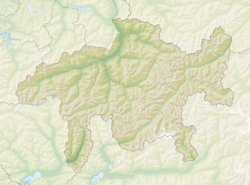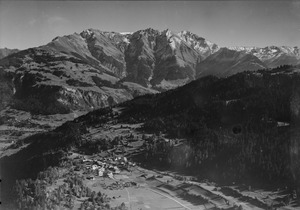Flond facts for kids
Quick facts for kids
Flond
|
||
|---|---|---|
 |
||
|
||
| Country | Switzerland | |
| Canton | Graubünden | |
| District | Surselva | |
| Area | ||
| • Total | 2.12 km2 (0.82 sq mi) | |
| Elevation | 1,072 m (3,517 ft) | |
| Population | ||
| • Total | 201 | |
| • Density | 94.8/km2 (245.6/sq mi) | |
| Postal code |
7137
|
|
| Surrounded by | Ilanz, Luven, Obersaxen, Rueun, Surcuolm | |
Flond is a small village located in the Swiss canton of Graubünden. It's part of the municipality of Mundaun in the Surselva district. In 2009, Flond joined with another village called Surcuolm to create the larger municipality of Mundaun.
A Look at History
Flond was first mentioned in official records way back in 1519. At that time, it was known by names like Flant or Flond.
Where is Flond?
Flond covers an area of about 2.1 square kilometers (which is about 0.8 square miles). A big part of this land, around 40.7%, is used for farming. Even more, about 51.7%, is covered by forests. The rest of the land, about 7.7%, is where buildings and roads are.
The village is located on a high area called the Obersaxen plateau. This plateau is south of the Vorderrhein river.
Who Lives in Flond?
As of 2008, Flond had a population of 201 people. Over the ten years before that, the number of people living in Flond grew by about 20.3%.
In 2000, a little more than half the population (55.1%) was male, and 44.9% was female. About 15.1% of the people were children aged 0 to 9, and 14.0% were teenagers aged 10 to 19.
Most adults were between 30 and 39 years old (19.0%). There were also many older people, with about 9.5% aged 60-69 and 10.6% aged 70-79.
Most people in Switzerland are well-educated. In Flond, about 76.2% of adults (aged 25–64) have finished high school or gone on to higher education, like university.
Flond has a very low unemployment rate, which means almost everyone who wants a job has one. In 2005, there were 14 people working in farming and 16 people working in manufacturing. Seven people worked in services, like shops or hotels.
Here's how Flond's population has changed over time:
| year | population |
|---|---|
| 1850 | 196 |
| 1900 | 193 |
| 1940 | 179 |
| 1950 | 162 |
| 1990 | 144 |
| 2000 | 179 |
What Languages are Spoken?
In 2000, most people in Flond spoke Romansh (50.8%). German was the second most common language (46.9%).
A long time ago, in the 1800s, almost everyone in Flond spoke Romansh (96.4% in 1880). This stayed true for a long time, even in the first half of the 1900s (90.5% in 1941). However, in the second half of the 1900s, more people started speaking German.
Here's a table showing the languages spoken in Flond over the years:
| Language | 1980 Census | 1990 Census | 2000 Census | |||
|---|---|---|---|---|---|---|
| Number | Percentage | Number | Percentage | Number | Percentage | |
| German | 21 | 18.92% | 45 | 31.25% | 84 | 46.93% |
| Romansh | 88 | 79.28% | 78 | 54.17% | 91 | 50.84% |
| Italian | 0 | 0.00% | 0 | 0.00% | 0 | 0.00% |
| Population | 111 | 100% | 144 | 100% | 179 | 100% |
In 1990, some people (about 8.33%) also said their first language was Portuguese.
See also
 In Spanish: Flond para niños
In Spanish: Flond para niños






